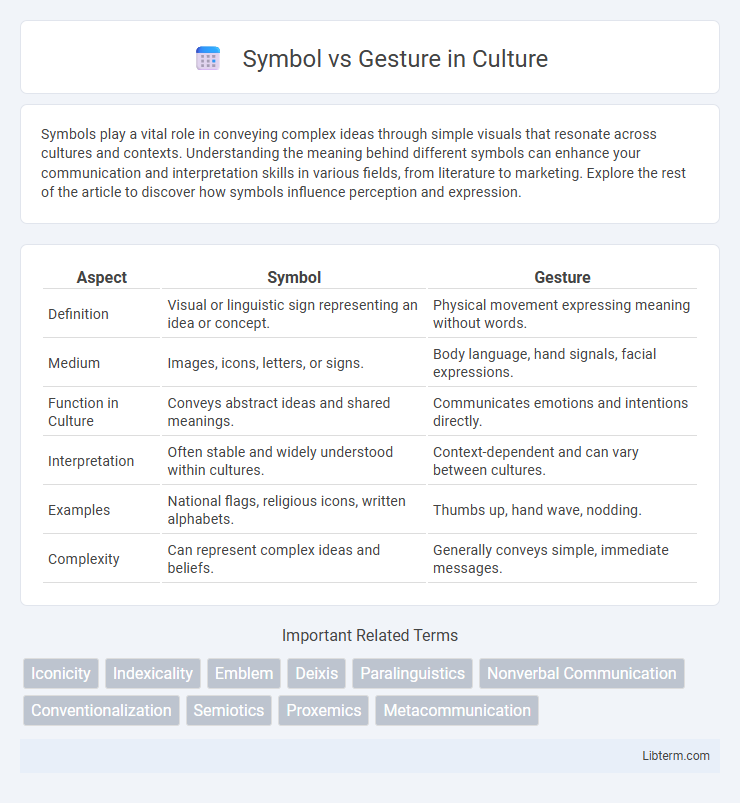Symbols play a vital role in conveying complex ideas through simple visuals that resonate across cultures and contexts. Understanding the meaning behind different symbols can enhance your communication and interpretation skills in various fields, from literature to marketing. Explore the rest of the article to discover how symbols influence perception and expression.
Table of Comparison
| Aspect | Symbol | Gesture |
|---|---|---|
| Definition | Visual or linguistic sign representing an idea or concept. | Physical movement expressing meaning without words. |
| Medium | Images, icons, letters, or signs. | Body language, hand signals, facial expressions. |
| Function in Culture | Conveys abstract ideas and shared meanings. | Communicates emotions and intentions directly. |
| Interpretation | Often stable and widely understood within cultures. | Context-dependent and can vary between cultures. |
| Examples | National flags, religious icons, written alphabets. | Thumbs up, hand wave, nodding. |
| Complexity | Can represent complex ideas and beliefs. | Generally conveys simple, immediate messages. |
Defining Symbols and Gestures
Symbols are culturally agreed-upon signs that represent ideas, objects, or relationships, often abstract and carrying specific meanings within a given context. Gestures involve physical movements, primarily of the hands or body, used to communicate nonverbally and convey emotions or intentions directly. Both symbols and gestures serve as fundamental components of human communication but differ in form and degree of abstraction.
Historical Evolution of Symbols and Gestures
Symbols and gestures have evolved distinctly through history, with symbols originating as visual representations in ancient cave paintings and hieroglyphics, serving as early communication tools across civilizations. Gestures, deeply rooted in human social behavior, developed as immediate, non-verbal expressions used in rituals, social interactions, and cultural practices throughout antiquity. Over time, the codification of symbols in written language contrasted with the fluid, context-dependent nature of gestures, reflecting the parallel yet interconnected evolution of human communication systems.
Cultural Significance of Symbols
Symbols serve as powerful cultural signifiers, encapsulating complex ideas, values, and identities within a society. Unlike gestures, which are often transient and context-dependent, symbols possess enduring cultural significance, conveying collective beliefs across generations. The study of symbols reveals insights into social norms, religious practices, and historical narratives that shape cultural heritage.
The Role of Gestures in Communication
Gestures play a crucial role in communication by complementing verbal language and enhancing message clarity through nonverbal cues such as hand movements, facial expressions, and body language. Unlike symbols, which are abstract representations relying on shared cultural understanding, gestures provide immediate, context-driven meanings that often convey emotions and intentions more effectively. Studies in communication theory highlight that gestures facilitate cognitive processing and social interaction by reinforcing spoken words and bridging gaps in language comprehension.
Differences Between Symbols and Gestures
Symbols are abstract representations or signs that convey meaning through culturally agreed-upon conventions, often found in language, art, and communication systems. Gestures involve physical movements of the body, especially the hands or face, that express ideas, emotions, or instructions directly without relying on symbolic interpretation. Unlike symbols, which require learned understanding, gestures can be universally recognized or contextually interpreted based on nonverbal cues.
Psychological Impact of Symbols and Gestures
Symbols evoke deep psychological responses by triggering collective memories and cultural meanings stored in the subconscious, fostering a sense of identity and belonging. Gestures impact psychology through nonverbal communication, influencing emotional states and social bonding by transmitting intentions and feelings instantly. Both symbols and gestures activate neural pathways associated with recognition and empathy, shaping human perception and interaction significantly.
Symbolism in Language and Art
Symbolism in language and art operates through the use of symbols--objects, shapes, or signs that represent abstract ideas or concepts beyond their literal meaning. Unlike gestures, which are direct physical movements conveying immediate intentions or emotions, symbols require cultural or contextual interpretation to unlock deeper significance. This layered meaning enables complex communication and artistic expression, connecting tangible representations to intangible thoughts and beliefs.
Gestures Across Different Cultures
Gestures across different cultures carry unique meanings that can lead to misunderstandings when interpreted through a universal lens. For instance, the thumbs-up gesture symbolizes approval in Western cultures but can be offensive in parts of the Middle East and West Africa. Understanding culturally specific nonverbal cues is essential for effective cross-cultural communication and avoiding misinterpretations.
The Interaction of Symbols and Gestures
Symbols and gestures interact dynamically, where symbols provide abstract meanings while gestures offer physical expressions that reinforce or modify those meanings. The interplay enhances communication by combining visual signs with bodily movements, enabling clearer conveyance of emotions and concepts. This interaction is crucial in contexts such as language development, cultural rituals, and digital interfaces where multimodal signaling optimizes understanding.
Modern Applications in Digital Communication
Symbols in digital communication serve as standardized icons or emojis that convey specific meanings quickly, enhancing clarity and reducing language barriers. Gestures, such as swipe movements and pinch-to-zoom on touchscreens, enable intuitive interaction with devices, improving user experience. Modern applications leverage both symbols and gestures to streamline communication and navigation in social media, messaging apps, and virtual environments.
Symbol Infographic

 libterm.com
libterm.com